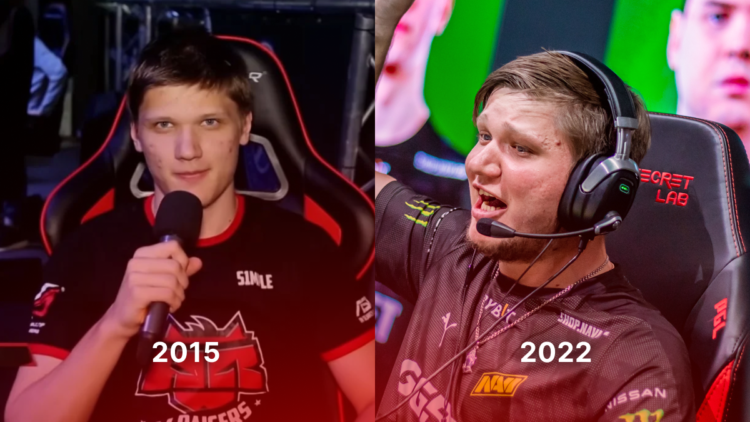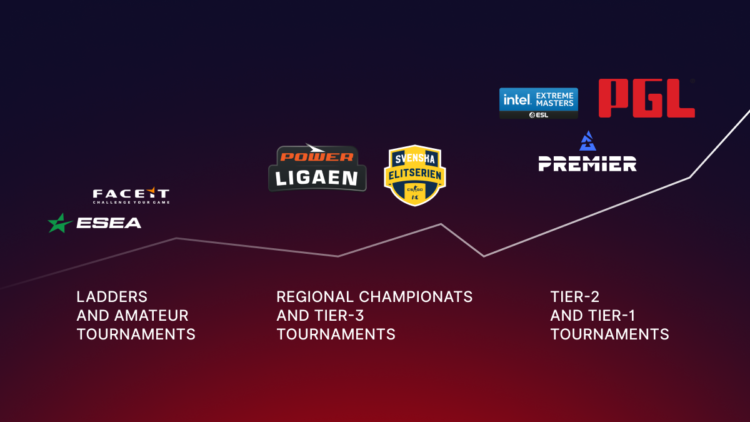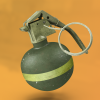
Unlike traditional sports, where teams always come first, professional players are the backbone, the pillars in our field. Any esports community is built from players, they form fanbases and even teams, win championships, and set the meta.
Being an esports athlete is fun: people play their favorite PC or console games and earn a lot of money. Can you imagine a better life?
Unfortunately, this is a common myth, and things are not as simple as they might seem. Players’ streams and social networks do not show what happens behind the scenes. To get into the elite, young people need either fabulous talent or continuous hard training. And today, a lazy lifestyle will no longer work inside esports, and the word ‘athlete’ finally starts to reflect reality. Best clubs and their academies require players to comply with the regime, engage in psychological and physical activities, exercise in the game for hours, and develop social networks. So, before becoming a natural esports athlete, you need to think carefully: are you ready to devote your life and youth to gaming, give all to training, and understand that there is a risk of not achieving anything? If the answer is yes, and ambitions and self-confidence push you forward, you’re good to go.
BLOG.CS.MONEY tries to unveil what’s behind the curtain of esports pro playing, what people need to do to become athletes, where to start, and what to expect and also gives a couple of useful links for beginners.
Getting On Feet: How Do Players Become Athletes?
The question is simple, and the answer is even more straightforward. Grind.
Before you try to blast in a team or start participating in tournaments, you should climb some solo peaks: get Global Elite, high FACEIT ELO, decent DM KDA, and beat warm-up records repeatedly. Then, every day, start with aim training, play for half an hour in deathmatch mode, and only then go into matchmaking.
Most likely, you already know what position suits you best: AWPer, lurker, anchor, maybe even IGL, rifler, support, or else. Don’t try to make yourself into something you’re not: the most outstanding players don’t always shoot with AWPs, and the best captains can have negative KDAs throughout their careers. Clearly understand your pros and cons: shooting, communication, map positions, grenades, tactics. Watch pro players and execute their ideas, feel free to apply what you learn, even YouTube tutorials have tons of good developmental content. Develop your own playstyle, whether it’s a melee AWP (a la m0nesy) or a perfect farmgun spray. Make a table: pros, cons, and things to work on. Ask your comrades, listen, but be wise and not angry. Look through your demos, and ask someone to look at them too.
Grind maketh pros.

It’s not too late to become an esports athlete if you’re 18 or 19 years old, don’t be bothered by star youngsters. Indeed, recent CS:GO scene activities show that clubs and orgs are aimed at Academies and very young players of 15-16 years old, but this does not mean that they can be more talented than you. Well, being a 20-years old can be your last chance, yet anything can happen.
Once you have set up your training routine and sharpened your skill to the max (at least in your opinion), it’s time to move on to the next step. But never stop the routine and shooting chores, not until you hang up your mouse!
So, young players have two options to develop: through the lower stage (Tier 3-4) or joining an academy.
Through hardship to HLTV tops
Option number one is the good old beaten track. Part-quoting Drake, starting from the bottom and nameless mixes, play hundreds of unknown tournaments and slowly work your way up.
Nowadays, it is much easier to find teams and live thanks to smaller tournaments. Leagues like ESEA offer good money for winning, considering you probably are still staying with your parents. Be sure to keep paychecks from victories so that if something happens, explain to your elders that esports is not a joke but a real way to earn money.
So you already have a team, huh? Great, skip this paragraph. If not, try to assemble it yourself or look on the Discord servers of various leagues. Ask the players you know, if someone needs +1 for tournaments, post LFTs on your social networks. Of course, it is best to try to play in tournaments with people you know, have chemistry with, and sharpen teamwork, but trying yourself with completely unknown players is also an important experience since it will help develop personal communication skills.
You have to participate in a lot of tournaments. It’s like poker, but instead of money, you will be rewarded with something more decisive: scouts from many organizations constantly watch many tournaments, whether small-town LANs with broadcasts for 15 people or online leagues without streams at all, only with statistics. Each drop of sweat will bring you closer to what you want to become.
Speaking of LANs. These days, more and more small computer clubs hold local tournaments in the capitals or just large cities, and they will be a great experience and a chance to break through to the top. As happened, for example, with the current Vitality player Kevin “Misutaaa” Rabier: he played LAN after LAN with a team of no-names, and as a result, older players noticed him.
TL;DR: get (or assemble) a team, slowly climb up the ESEA ladder, play small regional tournaments (Dust2.dk Ligaen in Denmark, Svenska Elitserien in Sweden, etc.), and try to get into tournaments highlighted by HLTV. And you’ll be noticed!

Academies are game-changers, yet hard
The difference between the first option and academies is that large organizations will start to work with young players closely and seriously, but the chances of getting into the core are much less. And there are not so many tournaments.
Academies provide players something the low-tier scene cannot: discipline and healthy development. Getting up early in the morning, meeting in TeamSpeak, training for 4-6 hours, studying tactics lessons, attending psychologists, and free time only in the evening. You will be watched, you will be helped, you will be guided, and maybe even paid. It works like any other college or university, a full-fledged study process.
But getting into academies is incredibly difficult. Player selection may happen often, but be honest: the rosters of NAVI Jr, MOUZ NXT, Furia, or BIG get updated once a year, and they simply enter into gentlemen’s agreements with promising players outside their current rosters.
As Andre “drop” Abreu, a Furia player who got promoted from the org’s Academy to the first team, said in a recent interview, while he played in the youth squad, he was also looking for a new team because he knew that the chance of getting a call was meager. And although in his case, everything went well, it happens that players part ways with organizations and become free agents, like Eugene “Aunkere” Karjat from NAVI Jr or many more.
In any case, we highly recommend applying to the Academies because they are the future. Here is a list that might help:
- Esportal x ENCE Academy (Finland) https://esportal.com/en/ence
- Road to NAVI (NAVI Jr – Ukraine, Kazakhstan, and Baltic countries) https://roadto.navi.gg/, https://navi.gg/en/publications/9704-cs-navi-jr-new-roster
- Path of a Ninja (Esportal, NIP, Area Academy – Nordics), https://esportal.com/en/pathofaninja
- BIG OMEN Academy Hunt (BIG – Germany), https://gobig.gg/omen
It won’t take that long to apply, and if accepted, consider your career started on a short path (but short doesn’t mean easy).
Gucci x FACEIT Academy
When this collaboration first came up, many people thought it was a joke. A brand like Gucci is hard to associate with esports, but voila, together with FACEIT, they have created something that can help all young athletes become better and find their future.
In short, this Academy is an extended version of the regular FACEIT Pro League, only with tons of educational content for young players and coach mentoring. Also, scouts are invited.
No kidding, this option can be decisive for some players, so don’t put it on the back burner.

Agencies
Worth mentioning separately: in addition to the academy, if you still decide to choose esports, you need to start working with a player agency. Now there are two of the largest: Prodigy Agency (by the way, they have youth lineups!) and Ulti Agency. They are open to young talents and will help you find, if not an academy, a low-tier mix in which you can safely play and grow.
Agencies are interested in communication because they live on it: the more successful their clients are, the higher their earnings. So just write them on socials or by email, it can be beneficial. In addition, they understand almost all languages!
How To Become A CS:GO Pro?
In short, two paths:
- Grind solo, find a team, play tournaments
- Apply to an Academy and learn to be a player there
Whichever path you end up with, esports can be difficult or even painful. But this is still a sport where constant work on yourself always pays off. Therefore, the most important thing is to improve your game’s aspects.
Find a team and play with them, trying to be better every day. Watch demos, work together, and listen to each other. Do not give up with a series of failures and a lose-streak, wait for results and cling to every chance. Remember, giving your 102% per day makes an additional +35% per year.
Browse through the stories of current stars: s1mple first spent a nightmare period in North America before becoming a legend. B1t, drop, and other youth players did not believe that they would be given a chance, but here they are playing in the final stages of the Majors as teenagers. MOUZ NXT are performing better and positioned higher in the HLTV top than the main roster. Tournament operators are following the footsteps of the WePlay Academy League and have started creating their youth leagues. People finally begin to take esports seriously, and by that, we mean the adult generation, parents, and sponsors who finance our careers.
Now is the best time to become esports stars. It’s going to pay off, but first, you have to sweat your pants off and believe in yourself.












